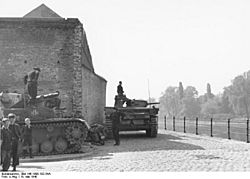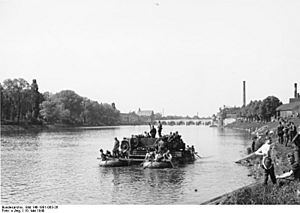Battle of Maastricht facts for kids
Quick facts for kids Battle of Maastricht |
|||||||
|---|---|---|---|---|---|---|---|
| Part of the Western Front of World War II | |||||||
 German Panzers in Maastricht (10 May 1940) |
|||||||
|
|||||||
| Belligerents | |||||||
| Commanders and leaders | |||||||
| Strength | |||||||
| 750 soldiers 4+ anti-tank guns 4 AA guns |
7th Air Division 4th Tank Division 343 tanks |
||||||
| Casualties and losses | |||||||
| 47 killed | 186 killed 9 tanks destroyed 9 armoured cars destroyed 10 aircraft shot down |
||||||
The Battle of Maastricht was an important fight at the start of World War II. It happened on May 10, 1940, in the city of Maastricht, Netherlands. This battle was part of Germany's plan to move quickly through the Netherlands and Belgium. Taking Maastricht was key for Germany to reach Fort Eben-Emael in Belgium. This would help them divide the Allied armies.
Contents
Why the Battle Started
Germany wanted to capture the bridges over the Maas River in Maastricht. They needed these bridges to move their troops and tanks easily into France. To do this, German teams dressed as regular people tried to sneak in. Their job was to stop the Dutch from blowing up the bridges. However, the Dutch soldiers caught them. When the German spies tried to run away, they were shot.
The Fight Begins
The battle started early in the morning. German soldiers on motorcycles approached a Dutch guard post. The Dutch let them get close, then opened fire. The Germans pulled back for a short time. But soon, more German soldiers arrived. The Dutch soldiers were outnumbered and had to retreat.
A strong concrete bunker, called a casemate, helped defend the sluice complex at Borgharen. This was a water control area that the Dutch also wanted to protect. The Dutch soldiers there fought hard. However, another Dutch group defending the north side of Maastricht had trouble. Their machine gun stopped working. This created a gap in the city's defenses. German soldiers quickly moved through this opening.
Fighting Around the City
The German 4th Tank Division faced delays in other areas. But a group of German tanks moving from the south advanced faster. They reached the outer defenses of Maastricht at Heugem. The Dutch had blocked the roads there. The Dutch defenders were told to fall back behind the Maas River once the outer defenses were broken.
A small group of Dutch soldiers stayed behind to slow the Germans down. They managed to destroy two German armored cars. This blocked the road for other German vehicles. When the German soldiers got too close, the Dutch sergeant ordered his men to retreat safely. They reached the west bank of the Maas River.
The Bridges Fall
By this time, only the railway bridge was still standing. The Germans saw it as a good way to cross the river with their tanks. Only 35 Dutch soldiers were defending it. The Dutch held off the Germans for a short time, killing a few. But the Germans had too many soldiers. The Dutch had to fall back.
As the Germans started to cross the bridge, the Dutch blew it up. It crashed into the river. With all the bridges destroyed, the Dutch goal was to hold off the Germans for as long as possible.
Last Stands
Even after the bridges were destroyed, some Dutch units kept fighting. They were spread out at different points. A group of Dutch snipers was in the towers near the bridge. When the Germans bravely set up an anti-tank gun, the Dutch snipers quickly shot its crew. A new crew tried, and they were also killed. The Germans then tried to cross the Maas River in small rubber boats. But the Dutch shot the boats to pieces. The Germans then pulled back from this spot.
The heaviest fighting happened near the destroyed railway bridge. The main German force joined the smaller group that had tried to take the bridge. Two German armored cars tried to approach but were destroyed by Dutch anti-tank rifles. A light tank was also knocked out. The Germans lost many soldiers. However, three more German armored cars soon arrived. The Dutch soldiers were in a very difficult spot. Many were killed or hurt. One of their anti-tank rifles was destroyed.
Surrender
The Dutch commander in Limburg, Lieutenant Colonel Govers, held a meeting. Earlier that day, Dutch soldiers had found German battle plans on a captured German soldier. These plans showed all the German units and their routes. It was clear that all the bridges were destroyed. It was also clear that a whole German tank division was in southern Limburg. The Dutch commander had only a few companies of soldiers left. They had no anti-tank guns or artillery.
The city of Maastricht was very old and had many important historical buildings. The commander decided that the city should not suffer more damage than needed. So, they decided to stop fighting the Germans in Maastricht. The commander himself went to the Wilhelmina Bridge with a white flag. Soon, they made contact with the Germans. A few hours later, all Dutch troops in Maastricht surrendered.
After the Battle
The Battle of Maastricht cost the lives of 47 Dutch soldiers. The exact number of German losses is not fully known. But it is thought that between 130 and 190 Germans died in the fighting. After the battle, 186 German bodies were found. Records show that 9 German armored cars and tanks were destroyed. Also, 10 German aircraft were shot down or crashed in southern Limburg. These were mainly transport planes and dive bombers.
See also
- List of Dutch military equipment of World War II
- List of German military equipment of World War II


